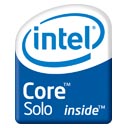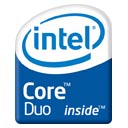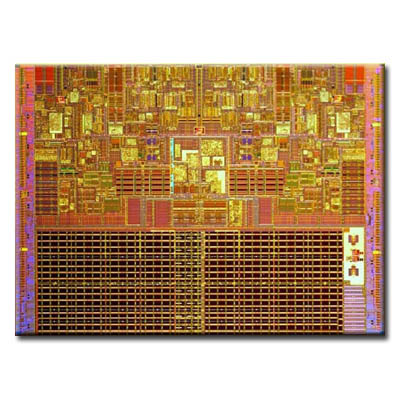Intel Core (Yonah) processors
Introduction: January 2006
Overview
The Core brand refered to Intel's 32-bit mobile dual-core x86 CPUs that derived from the Pentium M branded processors. The Core's microarchitecture was a slightly more advanced version of the Intel P6 architecture, that was eventually superseded by the new Core 2 microarchitecture. It emerged in parallel with the NetBurst (Intel P68) microarchitecture of the Pentium 4 brand, and was a precursor of the 64-bit Core microarchitecture of Core 2 branded CPUs. The Core comprised two branches: the Duo (dual-core) and Solo (Duo with one disabled core, which replaced the Pentium M brand of single-core mobile processor).
The Core brand was launched on January 5, 2006 by the release of the 32-bit Yonah core CPU - Intel's first dual-core mobile (low-power) processor. Its dual-core closely resembled two interconnected Pentium M branded CPUs packaged as a single die silicon chip. Hence, the 32-bit microarchitecture of Core branded CPUs - contrary to its name - had more in common with Pentium M branded CPUs than with the following 64-bit Core microarchitecture of Core 2 branded CPUs. Despite a major rebranding effort by Intel starting January 2006, some computers with the Yonah core continued to be marked as Pentium M.
In 2007, Intel began branding the Yonah core CPUs as Pentium Dual-Core intended for lower-end mobile only computers, unlike the 64-bit Core microarchitecture CPUs branded as Intel Core 2 Duo (for higher-end computers) and also as Pentium Dual-Core (for lower-end desktops only). In short, the Core brand refered to processors with the "mobile" derivative of 32-bit Intel P6 microarchitecture (preceding the Core microarchitecture), whereas the Intel Core 2 Duo brand refered to CPUs with the 64-bit Core microarchitecture.
September 2006 and January 4, 2008 marked a discontinuation of many Core branded CPUs.
The Yonah core
Yonah was the code name for (the core of) Intel's first generation of 65 nm process mobile microprocessors, based on the Banias/Dothan-core Pentium M microarchitecture. SIMD performance had been improved through the addition of SSE3 instructions and improvements to SSE and SSE2 implementations, while integer performance decreased slightly due to higher latency cache. Additionally, Yonah included support for the NX bit.
The Intel Core Duo brand refered to the world's first low-power (less than 25 watts) Yonah dual-core microprocessor, with the previous low being AMD's Opteron 260 and 860 HE at 55 watts. Core Duo was released on 5 January 2006, with the other components of the Napa platform. It was the first Intel processor to be used in Apple Macintosh products (although the Apple Developer Transition Kit machines, non-production units distributed to some developers, used Pentium 4 processors).
Contrary to early reports, the Intel Core Duo supported Intel VT x86 Virtualization Technology, except in the T2300E model and proprietary T2050/T2150/T2250 mounted by OEMs (cf. the Intel Centrino Duo Mobile Technology Performance Brief and Intel's Processor Number Feature Table). The Intel Pentium Dual Core processors may or may not had this feature. However, it seems some vendors, like HP, had chosen to disable this feature, with others making it available through a BIOS option.
Intel 64 (Intel's x86-64 implementation) was not supported by Yonah. However, Intel 64 support was integrated in Yonah's successor, the mobile version of Core 2, code-named Merom.
Intel Core Duo (product code 80539) consisted of two cores on one die, a 2MB L2 cache shared by both cores, and an arbiter bus that controled both L2 cache and FSB access. Upcoming steppings of Core Duo processors also included the ability to disable one core to conserve power.
Intel Core Solo (product code 80538) used the same two-core die as the Core Duo, but featured only one active core. This allowed Intel to sell dies that had a manufacturing defect in one but not both of the cores. Depending on demand, Intel may also simply disabled one of the cores to sell the chip at the Core Solo price - this required less effort than launching and maintaining a separate line of CPUs that physically only have one core. Intel used the same strategy previously with the 486 CPU in which early 486SX CPUs were in fact manufactured as 486DX CPUs but the FPU failed quality control and the connection was physically severed.
Core Duo contained 151 million transistors, including the shared 2MB L2 cache. Yonah's execution core contained a 12 stage pipeline, forecasted to eventually be able to run at a maximum frequency of 2.33–2.50GHz. The communication between the L2 cache and both execution cores was handled by a bus unit controller through arbitration, which reduced cache coherency traffic over the FSB, at the expense of raising the core-to-L2 latency from 10 clock cycles (in the Dothan Pentium M) to 14 clock cycles. The increase in clock frequency offset the impact of the increased clock cycle latency. The power management components of the core featured improved grained thermal control, as well as independent scaling of power between the two cores, resulting in very efficient management of power.
Core processors communicated with the system chipset over a 667MT/s front side bus (FSB), up from 533MT/s used by the fastest Pentium M. New T2050 & T2250 had also appeared in OEM systems as a low-cost option with a lower 533MHz FSB and no Virtualization Technology.
Yonah was supported by the 945GM, 945PM, 945GT, 965GM, 965PM, and 965GT system chipsets. Core Duo and Core Solo used Socket M, but due to pin arrangement and new chipset, functions were not compatible with any previous Pentium M motherboard.
The T2300E was later introduced as a replacement for the T2300. It had dropped support for Virtualization Technology. Early Intel specifications mistakenly claimed a halving of the Thermal Design Power.
The Duo version of Intel Core (Yonah) included two computational cores, providing performance per watt almost as good as any previous single core Intel processors. In battery-operated devices such as notebook computers, this translated to getting as much total work done per battery charge as with older computers, although the same total work might be done faster. When parallel computations and multiprocessing were able to utilize both cores, the Intel Core Duo delivered much higher peak speed compared to the single-core chips previously available for mobile devices.
The Yonah platform required all main-memory transactions to pass through the Northbridge of the chipset, increasing latency compared to the AMD's Turion platform. However, application tests showed Intel Core's L2-cache system was quite effective at overcoming main-memory latency; despite this limitation, Intel Core (Yonah) sometimes managed to outperform AMD's Turion.
According to Mobile Roadmaps from 2005, Intel's Yonah project originally focused more on reducing the power consumption of its P6+ Pentium M-based processor and aimed to reduce it by 50% for Intel Core (Yonah). Intel continued recommending Pentium NetBurst-based processors for mobile high performance applications (although these were less power efficient) until the Yonah project succeeded in extracting higher performance from its lower-power-consumption design. The Intel Core Duo's inclusion of two highly-efficient cores on one chip was able to provide better performance than a Pentium NetBurst core, but with much better power-efficiency.
There were two variants and one derivative of the Yonah, which did not bear the "Intel Core" brand name. A dual-core (server) derivative, code-named Sossaman, was released on 14 March 2006 as the Xeon (branded) LV (low-voltage). The Sossaman differed from the Yonah only in its support for dual-socket configurations (two CPUs - i.e. four cores - on board, like AMD Quad FX), and implementation of 36-bit memory addressing (PAE mode). A single-core variant, code-named Yonah-1024, was released as the Celeron (branded) M 400 series CPUs. It was largely identical to the Core Solo branded Yonah, except that it only had half the L2 cache and did not support SpeedStep. Another dual-core variant of the Core Duo branded Yonah was released as the Intel Pentium Dual-Core branded T2060, T2080, and T2130 mobile CPUs.
On July 27, 2006, Intel's Core 2 processors were released. By 2Q 2007, Intel expected 90% of its laptop CPU production to be converted to the heavily-revised Intel Core 2 processors. The original Intel Core (Yonah) product had an unusually short lifespan as a stepping stone to the 64-bit Intel Core 2.
Source: Wikipedia, the free encyclopedia.



